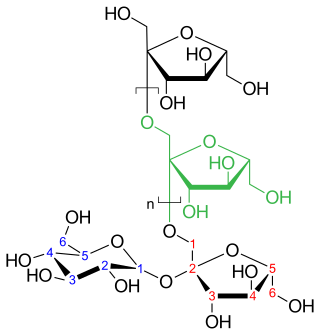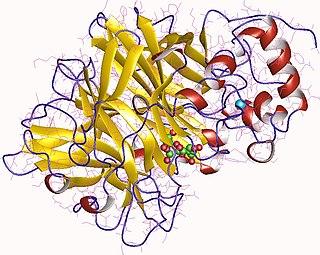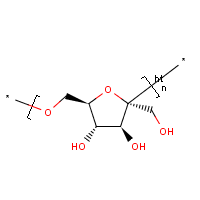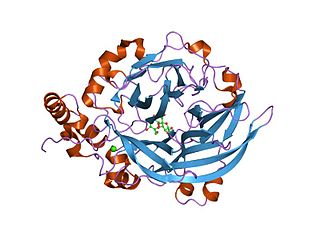
Inulins are a group of naturally occurring polysaccharides produced by many types of plants, industrially most often extracted from chicory. The inulins belong to a class of dietary fibers known as fructans. Inulin is used by some plants as a means of storing energy and is typically found in roots or rhizomes. Most plants that synthesize and store inulin do not store other forms of carbohydrate such as starch. In the United States in 2018, the Food and Drug Administration approved inulin as a dietary fiber ingredient used to improve the nutritional value of manufactured food products. Using inulin to measure kidney function is the "gold standard" for comparison with other means of estimating glomerular filtration rate.

A fructan is a polymer of fructose molecules. Fructans with a short chain length are known as fructooligosaccharides. Fructans can be found in over 12% of the angiosperms including both monocots and dicots such as agave, artichokes, asparagus, leeks, garlic, onions, yacón, jícama, barley and wheat.

Fructosides are glycosides where the glycone group is fructose.
The enzyme inulin fructotransferase (DFA-I-forming) catalyzes the following process:
The enzyme levan fructotransferase (DFA-IV-forming) catalyzes the following process:
In enzymology, a sinapoylglucose---sinapoylglucose O-sinapoyltransferase is an enzyme that catalyzes the chemical reaction
In enzymology, a 6G-fructosyltransferase is an enzyme that catalyzes the chemical reaction
In enzymology, an aldose beta-D-fructosyltransferase is an enzyme that catalyzes the chemical reaction
In enzymology, an inulosucrase is an enzyme that catalyzes the chemical reaction

Levansucrase is an enzyme that catalyzes the chemical reaction
In enzymology, a sucrose:sucrose fructosyltransferase is an enzyme that catalyzes the chemical reaction
In enzymology, a glycoprotein-fucosylgalactoside alpha-N-acetylgalactosaminyltransferase is an enzyme that catalyzes the chemical reaction

Levan is a naturally occurring fructan present in many plants and microorganisms. This polymer is made up of fructose, a monosaccharide sugar, connected by 2,6 beta glycosidic linkages. Levan can have both branched and linear structures of relatively low molecular weight. Branched levan forms a very small, sphere-like structure with basal chains 9 units long. The 2,1 branching allows methyl ethers to form and create a spherical shape. The ends of levan also tend to contain a glucosyl residue. Branched levan tends to be more stable than linear polysaccharides. However, the amount of branching and length of polymerization tends to vary among different species. The shortest levan is 6-kestose, a chain of two fructose molecules and a terminal glucose molecule.

In molecular biology, glycoside hydrolase family 68 is a family of glycoside hydrolases.
Inulinase is an enzyme with systematic name 1-β-D-fructan fructanohydrolase.
2,6-β-Fructan 6-levanbiohydrolase is an enzyme with systematic name (2→6)-β-D-fructofuranan 6-(β-D-fructosyl)-D-fructose-hydrolase. This enzyme catalyses the following chemical reaction
Fructan β-fructosidase is an enzyme with systematic name β-D-fructan fructohydrolase. It catalyses the hydrolysis of terminal, non-reducing (2→1)- and (2→6)-linked β-D-fructofuranose residues in fructans.
Fructan beta-(2,1)-fructosidase is an enzyme with systematic name beta-(2->1)-D-fructan fructohydrolase. This enzyme catalyses the following chemical reaction
Fructan beta-(2,6)-fructosidase is an enzyme with systematic name (2->6)-beta-D-fructan fructohydrolase. This enzyme catalyses the following chemical reaction

Kestose is a class of sugars that belongs to a group of fructooligosaccharides.






